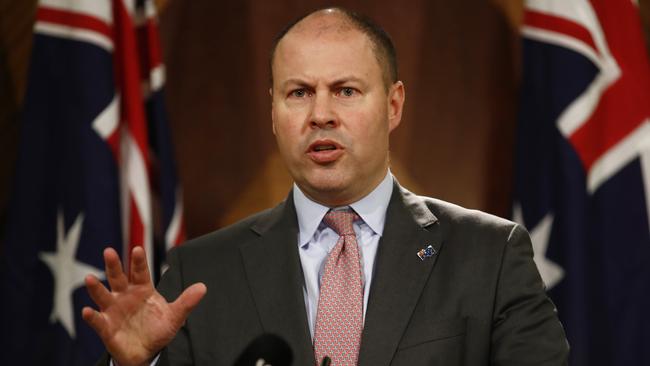JobKeeper, JobSeeker and Coronavirus Supplement saved 500,000 families
JobKeeper and JobSeeker helped prevent almost half a million Australian households losing their homes or going into housing stress.

Almost half a million Australian households have been spared the risk of losing their homes or being forced into housing stress because of JobKeeper, JobSeeker and Coronavirus Supplement payments, economic research has found.
But almost a quarter of those could be tipped into extreme housing affordability stress once those subsidies begin to be withdrawn in 2021.
Separate Treasury analysis of banking data obtained by The Australian reveals the tapering-off of JobSeeker and JobKeeper payments in September has not had an impact on household savings and spending.
More than $100bn has been accumulated during the pandemic, with the accounts of JobSeeker recipients rising by more than 30 per cent, and credit card balances down by 17 per cent.
The independent economic modelling from the University of Adelaide and Curtin University shows the number of households on the brink of being thrust into “devastating” home affordability or mortgage stress would have doubled had it not been for government payments.
The modelling examines three employment scenarios and warns the jobless rate could be between 8.7 per cent and 15.1 per cent next year. Under a worst-case scenario — in the event of no vaccine being available — unemployment could swell to more than 1.75 million and thrust 124,000 families back into housing stress.
The modelling, commissioned for the Australian Housing and Urban Research Institute, shows that without government intervention, 1.336 million households would have been classified as living under housing affordability stress. Chris Leishman, the lead author of the report said: “Without government intervention, Australian households in housing affordability stress would have nearly doubled … even after Commonwealth Rent Assistance had been taken into account.
“The modelling reveals that some 103,500 households entered situations of housing affordability stress as a result of the pandemic.
“The policy concern is that if these highly successful government interventions are withdrawn prematurely, almost a third of those saved from suffering housing affordability stress will now experience it.
“Without an extension of the JobKeeper income support measures beyond March 2021, the number of households living in HAS is likely to increase significantly, to at least 793,000, and could reach as high as 893,000.”
Housing affordability stress is defined as people in the bottom 40 per cent of income earners who spend more than 30 per cent of their income on mortgage payments or rent.
“The JobKeeper and JobSeeker interventions reduced the incidence of housing affordability stress by a considerable amount: 861,500 households compared to 1,336,000 without the intervention,” the report found.
“As JobKeeper moves through its later phases, (housing affordability stress) gradually rises by a further 62,000-124,000 and more than 70 per cent of these households are private renters. The 2021 scenario modelling shows that Commonwealth Rental Assistance is not sufficient to fully mitigate the impacts of an economic downturn in any of the scenarios examined and households in HAS rise from the baseline 757,000 to at least 797,000 to 893,000.”
The modelling was based on the government assistance payments and did not take into account any “loan interest holidays” offered by the banks as the majority of people forced into housing affordability stress are private renters.
The Treasury analysis found that, for JobSeeker recipients, bank balances had increased while credit card balances had significantly decreased.
Data provided by one of the major banks to Treasury showed JobSeeker recipients had increased transaction/savings accounts by up to 31 per cent between April and October.
Mortgage offset account balances were up 20 per cent over the same period while credit card balances were down 17 per cent.
Josh Frydenberg said it was “important that as we move into the recovery phase, these temporary and targeted supports are being tapered to provide a smooth transition so that households and businesses can plan with certainty”.
The Adelaide University research modelled a “hypothetical phase four” of the JobKeeper payment — reduced to $650 a fortnight — which it claimed would keep the number of households under stress below the baseline number.
Professor Leishman said his team had also modelled three unemployment scenarios prior to the second-wave COVID-19 outbreak in Victoria based on Australian Bureau of Statistics data. He said the job losses and potential job losses had been and were likely to be in industries including arts, leisure, accommodation and food services.
Under the worst-case scenario, accommodation and food services would be hardest hit with unemployment rates of up to 31.8 per cent.








To join the conversation, please log in. Don't have an account? Register
Join the conversation, you are commenting as Logout